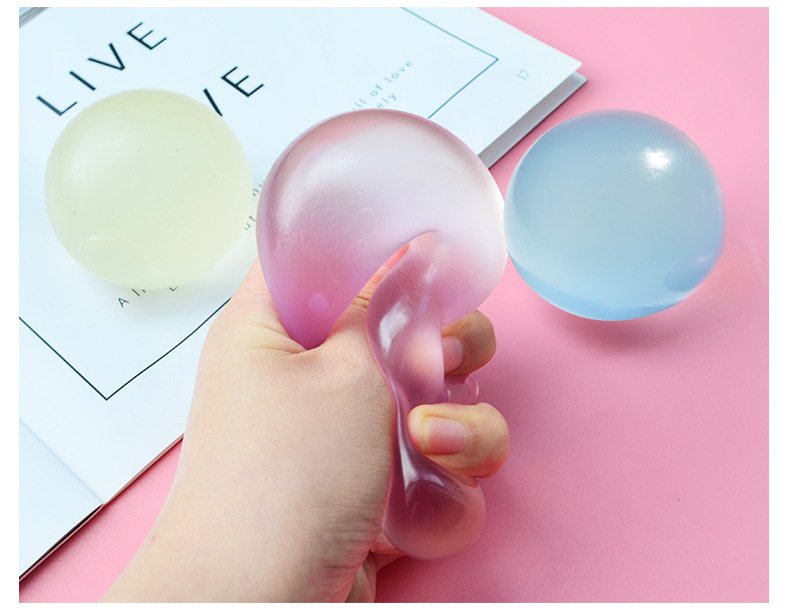Slow Rising Stress Ball Color Changing in the Sunlight
- Heavier than ordinary stress ball, more suitable for hand exercises
- Squeeze it, slow-rising
- Color changing in the sunlight
- Optional with emoji printing
- Suitable as promotional gifts for adults and children of age 3+
Description
Understanding the Mechanism: How Do Color-Changing Stress Balls Work?
The science behind color-changing stress balls, particularly in sunlight, is rooted in the fascinating properties of thermochromic and photochromic pigments. These pigments are specially designed to react to different wavelengths of light, allowing the stress balls to exhibit a spectrum of colors when exposed to varying environmental conditions.
Thermochromic pigments change color in response to temperature variations. These pigments contain liquid crystals that undergo a structural transformation when heated or cooled, thereby altering their color. When incorporated into the silicone or rubber material of stress balls, these pigments enable the balls to shift hues as they absorb heat from the sun or cool down in the shade.
Photochromic pigments, on the other hand, are activated by ultraviolet (UV) light. These pigments contain molecules that rearrange their structure upon exposure to UV rays, resulting in a visible color change. When stress balls embedded with photochromic pigments are exposed to sunlight, the UV light triggers a chemical reaction that alters the ball’s color, creating a dynamic visual effect.
The manufacturing process of color-changing stress balls involves blending these specialized pigments into the base material, usually silicone or rubber. The pigments are evenly distributed throughout the material to ensure consistent color changes. During production, the base material is heated to a specific temperature to allow the pigments to integrate seamlessly.
UV light and temperature play pivotal roles in the color-changing process. Thermochromic pigments rely on the heat from the sun to transition between colors, while photochromic pigments depend on UV light to initiate their color shift. This dual mechanism makes these stress balls particularly intriguing, as they can exhibit a variety of colors depending on the intensity of sunlight and ambient temperature.
In essence, the interaction between thermochromic and photochromic pigments with environmental factors like UV light and temperature underpins the captivating phenomenon of color-changing stress balls. This interplay of science and material engineering not only creates an engaging sensory experience but also illustrates the remarkable ways in which advanced materials can respond to natural elements.
Practical Applications and Benefits of Color-Changing Stress Balls
Color-changing stress balls have emerged as a versatile tool with a plethora of practical applications and benefits. Their primary function is to alleviate stress, with the added advantage of a visual transformation that can significantly enhance their calming effect. When an individual squeezes a color-changing stress ball, the gradual shift in color can serve as a visual indicator of tension release, providing an immediate, tangible sense of relief. This dual sensory experience—tactile and visual—can be particularly effective in reducing anxiety and promoting relaxation.
In educational settings, color-changing stress balls offer an engaging method to teach children about the principles of light and color changes. Through hands-on interaction, students can observe the impact of pressure and heat on the stress balls, making abstract scientific concepts more concrete and accessible. This interactive approach not only aids in comprehension but also stimulates curiosity and encourages active learning.
Therapeutically, color-changing stress balls are valuable tools in psychology and occupational therapy. Therapists often incorporate them into treatment plans for individuals coping with stress, anxiety, and sensory processing disorders. The visual feedback provided by the color change can help patients become more aware of their stress levels, facilitating better self-regulation and coping strategies. Additionally, the repetitive squeezing motion can improve fine motor skills and hand strength, which is beneficial for patients recovering from hand injuries or surgeries.
Beyond their practical applications in stress relief and education, color-changing stress balls hold significant novelty and entertainment value. Their unique ability to change colors under sunlight or pressure makes them attractive promotional items and gifts. Companies often use them as branded merchandise, capitalizing on their appeal to a broad audience. The combination of functionality and fun ensures that these stress balls are not only effective but also memorable.
Real-life examples and testimonials underscore the effectiveness and versatility of color-changing stress balls. Users frequently report a noticeable reduction in stress and an increased sense of calm. Educators and therapists alike praise their utility in both classroom and clinical settings, highlighting their multifaceted benefits.









